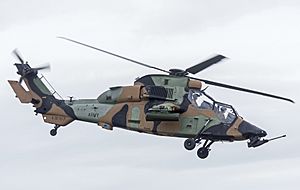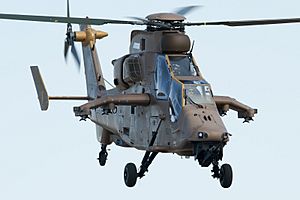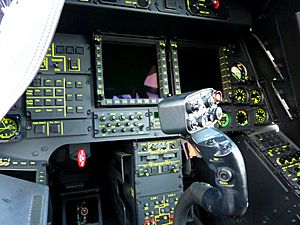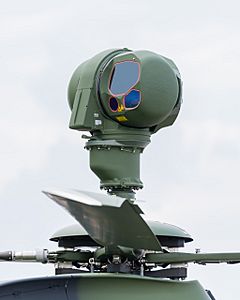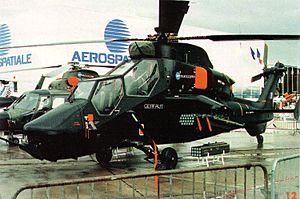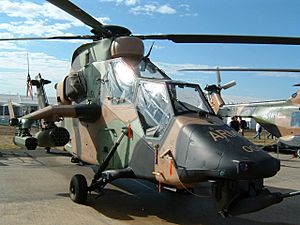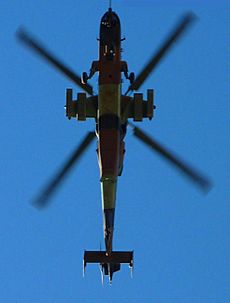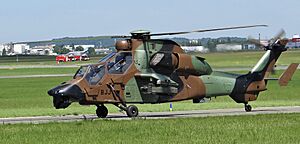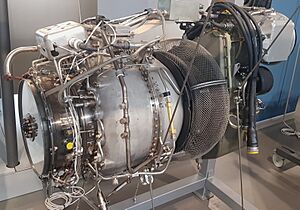Eurocopter Tiger facts for kids
Quick facts for kids Tiger/Tigre |
|
|---|---|
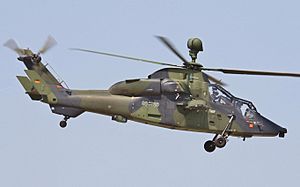
Eurocopter Tiger of the German Army
|
|
| General information | |
| Type | Attack helicopter |
| National origin | Multinational |
| Manufacturer | Eurocopter Airbus Helicopters |
| Status | In service |
| Primary users | French Army |
| Number built | 180 as of July 2019 |
| History | |
| Manufactured | 1991–present |
| Introduction date | 2003 |
| First flight | 27 April 1991 |
The Eurocopter Tiger is a powerful helicopter. It has four blades and two engines. It first started flying for armies in 2003. Airbus Helicopters makes it. This company used to be called Eurocopter.
In France and Spain, this helicopter is called the Tigre. This word means "Tiger" in French and Spanish. In Germany and Australia, it is simply called the Tiger.
The Tiger helicopter was first planned during the Cold War. It was meant to fight tanks if there was a big war in Europe. But the Cold War ended. So, France and Germany decided to make the Tiger a helicopter that could do many different jobs. It became ready for action in 2008.
The Tiger was the first helicopter in Europe made almost entirely from special strong, light materials called composites. Even the first models had cool features. These included a 'glass cockpit' with digital screens. It also had stealth technology to help it hide. Its design made it very agile, meaning it could move quickly and easily. This helped it avoid being hit. Newer versions have stronger engines and can carry more weapons. Tigers have been used in real battles in Afghanistan, Libya, and Mali.
Contents
How the Tiger Helicopter Was Developed
Starting the Project
In 1984, France and West Germany wanted a new, advanced helicopter. France wanted one to protect other helicopters and fight enemy helicopters. Germany wanted one mainly to destroy tanks.
They planned to buy 427 helicopters in total. Germany wanted 212 anti-tank helicopters. France wanted 75 support helicopters and 140 anti-tank helicopters.
A group of companies, Aérospatiale and MBB, was chosen to build it.
Challenges and Changes
In 1986, the project almost stopped because it was becoming too expensive. Some thought it would be cheaper to buy American helicopters. The French Defence Minister even said the joint project was more costly than if each country built its own. A report in July 1986 said the project was not meeting the military's needs.
France and Germany then changed how the project worked. They made companies take more financial risk. Thomson CSF took over much of the electronic work. Even with problems, the project officially restarted in November 1987. They focused more on the helicopter's ability to fight tanks. The project's organization was quickly rebuilt between 1987 and 1989. A special Franco-German Helicopter Office was set up in May 1989.
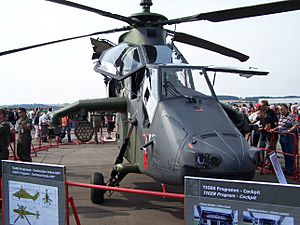
In November 1989, Eurocopter signed a deal to fund the helicopter's development. This included building two assembly lines. One was in France and one in Germany. They also planned to build five test helicopters. Three were for unarmed testing. Two were armed prototypes, one for France and one for Germany. The very first Tiger helicopter flew on April 27, 1991. Its first flight lasted 30 minutes.
After the Cold War ended, defense budgets were cut. This led to more questions about the Tiger project. Germany wanted the Tiger to do more than just fight tanks. They wanted it for scouting, supporting ground troops, and escorting other helicopters.
In 1992, Aérospatiale and MBB joined with other companies to form the Eurocopter Group. This helped the Tiger project move forward. In December 1996, France and Germany made a big agreement. This secured the Tiger's future. It also included developing new missiles for the helicopter.
Some political issues still affected sales. A plan to sell 145 Tigers to Turkey failed. Turkey chose the Tiger, but disagreements between Eurocopter, France, and Germany stopped the deal.
Orders and Deliveries
On June 18, 1999, Germany and France officially ordered 160 Tiger helicopters. Each country ordered 80. The cost was about €3.3 billion. The first production Tiger was shown in March 2002. The first official delivery to the French Army was on March 18, 2005. Germany received its first Tiger on April 6, 2005. Germany later reduced its order to 57 helicopters in March 2013.
France's budget in 2013 showed their share of the project was €6.4 billion. This meant the total cost for the main partners was about €14.7 billion. In December 2015, France ordered 7 more HAD helicopters. They planned to upgrade their entire fleet to the HAD version by 2025. This would make a total of 67 helicopters.
Selling to Other Countries
In the 1990s, there was interest in selling the Tiger to Britain and the Netherlands. Eurocopter wanted to start production quickly to help with export deals. Both countries were lobbied to choose the Tiger. However, neither Britain nor the Netherlands ended up buying the Tiger.
On December 21, 2001, Eurocopter won a contract to provide 22 Tiger helicopters to the Australian Army. These were a special ARH (Armed Reconnaissance Helicopter) version. They had new communication and navigation systems. Most of these helicopters were put together in Australia. In July 2007, Australia stopped payments due to delays. By 2008, most problems were fixed, and payments restarted. The last Tiger ARH was delivered to Australia in December 2011. In August 2019, Australia announced plans to replace its Tiger ARH helicopters.
In September 2003, Spain chose a version of the Tiger called the HAD. Spain ordered 24 of these helicopters. They would carry PARS 3 LR and Mistral missiles. They also had stronger engines. Deliveries of the HAD version began in 2007. Spain also joined the Tiger program. Soon after, France decided to buy the multi-role Tiger HAD instead of its original anti-tank version.
In July 2006, Saudi Arabia signed a large contract for 142 helicopters, including 12 Tiger attack helicopters. But this deal was canceled in late 2007 for unknown reasons.
In May 2007, the Tiger competed to be chosen by the Indian Air Force. In 2011, Tigers took part in missile firing tests for India. In 2012, the Tiger also competed for a contract in South Korea. However, South Korea chose the Boeing AH-64 Apache in April 2013. By December 2015, the Tiger was being considered by Poland to replace their older helicopters.
In June 2024, the Ukrainian Government showed interest in buying Australia's Tiger fleet.
How the Tiger Helicopter is Designed
Overview of Features
The Tiger can do many different combat jobs. These include scouting, watching, fighting tanks, and supporting ground troops. It can also protect friendly forces. It works day or night, in all weather, and even after chemical attacks. The Tiger can also fly from ships, even in bad weather.
One special thing about the Tiger is how agile it is. It can move very quickly and perform amazing turns. This is thanks to its 13-meter, four-bladed main rotor. The Tiger can even do full loops and negative 'g' maneuvers. Two powerful FADEC-controlled MTU Turbomeca Rolls-Royce MTR390 engines power it.
The Tiger has a 'glass cockpit' with two seats, one behind the other. The pilot sits in front, and the gunner sits behind. Both crew members can control the weapons or fly the helicopter. They can switch roles if needed. The pilot usually handles self-defense and communications.
Pilots new to the Tiger need a lot of training. This is because it is very different from older helicopters. It has more capabilities and requires managing more tasks. Andrew Warner, a chief test pilot, said it was "the easiest-handling aircraft I have ever flown."
The cost of the Tiger varies by version. Australia's Tiger ARH cost about A$68 million per helicopter. The newer Tiger HAD version costs about US$44–48 million.
Staying Safe in Combat
The Tiger has special protection systems to help it survive. It uses stealth technology. This means its visual, radar, infrared, and sound signals are reduced. This helps it avoid being detected by enemies. Andrew Warner said the Tiger's survival "relies on stealth and agility."
Using composite materials in its body helps reduce its radar cross-section (RCS). This makes it harder for radar to see. It also reduces its heat and sound signals. The helicopter's body is armoured. It can withstand small arms fire and 23 mm cannon rounds. The Tiger also has systems to warn of radar, lasers, and incoming missiles. It can also release flares and chaff to trick missiles.
The Tiger was the first all-composite helicopter made in Europe. Its body is 80% carbon fiber and kevlar. The rest is aluminum and titanium. The tail section is entirely made of composites. The rotors are made of a special plastic composite. This material can withstand damage in combat and bird strikes. The Tiger's structure also protects against lightning and electromagnetic pulses.
The Tiger is designed to be very safe in a crash. Many of its systems have backups. They are also separated to reduce damage if one part is hit. Parts of the engine system, like the rotors, are made to be very tough. The gearbox can run for 60 minutes even if it loses oil. Fuel is stored in two main tanks and two smaller tanks in the wings. The fuel tanks can seal themselves if they are hit. In Afghanistan, the Tiger was available for operations 90% of the time.
Electronics and Weapons
The Tiger has advanced electronics. These include the EUROGRID system for managing the battlefield and displaying maps. It has integrated communication systems and data links. It also has a digital flight control system. Two mission computers control weapons, sensors, and targeting. The Tiger's navigation system uses GPS, radar, and other sensors. A special forward-looking infrared (FLIR) sensor helps the pilot fly at night.
Each crew member has two digital screens. These show information about the helicopter's systems and sensor data. They also use a helmet-mounted display (HMD). The pilot uses the HMD to see flight data and night vision images. The gunner uses it to control weapons and see targeting information.
A very important electronic system is the mast-mounted Osiris sight/sensor. This system is on top of the rotor. It has cameras, a laser range finder, and gyroscopes for stability. Osiris helps find and track targets. It sends targeting data to the weapons computer. It can also find targets without being detected. This system was made to work well with the Trigat anti-tank missile. Some Tiger versions have a different optical system on the helicopter's roof.
The Tiger can carry many different weapons. These include rockets, cannons, and various air-to-air and air-to-surface missiles. A special computer controls these weapons. For ground attacks, it has a 30 mm Nexter gun under its nose. It can also carry gun pods, anti-tank missiles, and rocket launchers on its stub wings. The Tiger can use missiles like the Mistral that can hit targets even if they are not directly in front. A guided 70 mm rocket is also being developed for the Tiger.
How the Tiger Has Been Used
In December 2008, the Tiger HAP and UHT versions were fully ready for combat. In May 2009, the Tiger was tested for use on ships. By November 2009, almost 50 Tigers had been delivered. They had flown over 13,000 hours worldwide.
In July 2009, three French Tiger HAP helicopters went to Afghanistan. This was the first time the Tiger was used in a combat zone. They flew missions to scout and support ground troops fighting the Taliban. By July 2010, the French Tigers had flown 1,000 hours in Afghanistan. On February 4, 2011, a French Tiger crashed near Kabul. Both crew members had minor injuries.
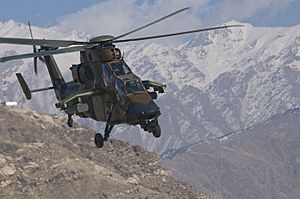
In August 2009, a German magazine reported that Germany's ten operational Tigers were only good for training. Other Tigers had problems. In May 2010, Germany stopped deliveries due to "serious defects, especially with wiring." Eurocopter said they were fixing the wiring problems.
During the 2011 military intervention in Libya, France sent a ship with Tiger helicopters to the Libyan coast. On June 4, 2011, French Tigers, along with British Apache helicopters, began combat operations in Libya.
In December 2012, four German Tiger UHTs went to Afghanistan. They flew missions to scout, support ground troops, and protect convoys. These Tigers had been upgraded. They had new defense systems, sand filters for the engines, and better communications. Between January 2013 and June 2014, German Tigers flew 1,860 hours. They supported NATO troops and Afghan forces. On May 4, 2013, a German Tiger fired its weapons in combat for the first time. It used rockets and machine gun fire to support special forces.
In March 2013, Spain also sent three Tiger HADs to Afghanistan. They supported Spanish ground forces.
In January 2013, France sent Tigers to Mali as part of its military action there. Early HAD models joined in November 2014. In March 2017, German Tigers went to Mali to support a UN mission. On July 26, one German Tiger crashed in the desert. Both pilots died. An investigation found that mistakes by maintenance contractors caused the crash.
Different Types of Tiger Helicopters
Germany's Tiger: KHT/UHT
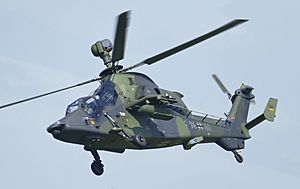
The KHT (which means "Attack Helicopter Tiger" in German) is a multi-role helicopter for the German Army. Until October 2013, it was called the UHT ("Support Helicopter Tiger"). Germany plans to have 51 Tiger UHs. The KHT can carry "fire and forget" anti-tank missiles and 70 mm rockets. It also has four AIM-92 Stinger missiles for air-to-air combat. Unlike some other versions, it does not have a built-in gun turret. But a 12.7 mm gun pod can be added. This version is designed to be flexible for many different missions. It also uses a mast-mounted sight with advanced cameras.
France's Tiger: HAP
The Tiger HAP (meaning "Support and Escort Helicopter" in French) is for air-to-air combat and fire support for the French Army. It has a 30 mm GIAT 30 gun under its chin. It can carry 68 mm unguided rockets or 20 mm machine cannons. It also carries Mistral air-to-air missiles. France had 40 HAP helicopters by 2012. In December 2015, France decided to upgrade all its HAP Tigers to the HAD standard by 2025.
Spain's Tiger: HAD
The Tiger HAD (meaning "Support and Destruction Helicopter" in French and Spanish) is similar to the HAP. But it is better for hot places. It has 14% more engine power from upgraded MTR390 engines. Its maximum take-off weight is higher. It has better communication systems and stronger armor. It carries Hellfire II and Spike ER anti-armor missiles. It is good for attacking, escorting, supporting ground troops, scouting, and air-to-air combat.
The Spanish Army chose this version. The French Army also decided to upgrade most of its HAP helicopters to the HAD version. In December 2004, Spain ordered 24 HADs, and France ordered 40 HADs.
Future Upgrades
In January 2016, France, Australia, Germany, and Spain discussed a new upgrade called the Mk III. This upgrade was planned for around 2023. It would include a common anti-tank missile and better communication systems.
In March 2022, Airbus agreed with France and Spain to start the Mk III program. 42 French helicopters will be upgraded, starting in 2029. 18 Spanish helicopters will be upgraded, starting in 2030. The first Mk III prototype is expected to fly in 2025. Each country's Mk III will be slightly different. Upgrades include better sensors, helmet sights, vision systems, radios, and data links. They will also get new air-to-surface and air-to-air missiles, guns, and rockets. Improved defenses, a new navigation system, and updated electronics are also part of the plan. The Mk III will use the MAST-F missile instead of the Hellfire II.
Australia's Tiger: ARH
The Tiger ARH (Armed Reconnaissance Helicopter) was ordered by the Australian Army. It replaced their older helicopters. The ARH is an upgraded HAP version. It has stronger MTR390 engines. It also has a laser designator for firing Hellfire II missiles. Instead of SNEB rockets, the ARH uses 70 mm rockets from a Belgian company. Australia ordered 22 of these helicopters in December 2001. Most were based in Darwin. They were shipped to Australia in parts and assembled there.
The first two ARH helicopters arrived in Australia on December 15, 2004. All deliveries were planned by June 2010. In 2012, pilots refused to fly after three incidents with cockpit fumes. All safety concerns were addressed.
In August 2014, the Australian Defence Force successfully tested a laser guidance kit for the ARH's 70mm rockets.
Australia's 2016 Defence White Paper said the Tiger helicopters would be replaced in the mid-2020s. Reasons included that they were not common with other Tiger versions. Also, the engines had high maintenance costs. Sending parts to Europe for repair took a long time.
The Australian Army's Tiger ARHs were fully operational by April 18, 2016. In April 2019, the maintenance contract was renewed until 2025.
In July 2019, Australia started looking for a replacement for their Tiger helicopters. They wanted a "proven and mature, manned, off-the-shelf armed helicopter." It also needed to operate from Australia's growing fleet of helicopter-capable ships. They wanted new helicopters by 2026 and all 29 by 2029.
In January 2021, the Australian Government announced it would buy 29 AH-64E Apache Guardians to replace the Tigers.
Who Uses the Tiger Helicopter?
 Australia Australian Army
Australia Australian Army
- 1st Aviation Regiment (will be replaced by AH-64E Apache Guardian by 2028)
 France French Army
France French Army
- 1st Combat Helicopter Regiment
- 4th Special Forces Helicopter Regiment
- 5th Combat Helicopter Regiment
 Germany German Army
Germany German Army
- Army Aviation Helicopter Regiment 36 (will be taken out of service by 2032)
 Spain Spanish Army
Spain Spanish Army
- Attack Helicopter Battalion 1
Tiger HAP Specifications
Data from Wilson, McGowen
General characteristics
- Crew: 2 (pilot and weapon systems officer)
- Length: 14.08 m (46 ft 2 in) fuselage
- Height: 3.83 m (12 ft 7 in)
- Airfoil: blade root: DFVLR DM-H3; blade tip:DFVLR DM-H4
- Empty weight: 3,060 kg (6,746 lb)
- Gross weight: 5,090 kg (11,222 lb)
- Max takeoff weight: 6,000 kg (13,228 lb)
- Fuel capacity: 1,080 kg (2,381 lb) internals
- Powerplant: 2 × MTR MTR390 turboshaft engines, 972 kW (1,303 shp) each
- Main rotor diameter: 13 m (42 ft 8 in)
- Main rotor area: 132.75 m2 (1,428.9 sq ft)
Performance
- Maximum speed: 290 km/h (180 mph; 157 kn) with rotor head mast
-
-
-
- 315 km/h (196 mph; 170 kn) without rotor head mast
-
-
- Range: 800 km (497 mi; 432 nmi)
- Ferry range: 1,300 km (808 mi; 702 nmi) with external tanks on the inboard hardpoints
- Service ceiling: 4,000 m (13,000 ft)
- Rate of climb: 10.7 m/s (2,110 ft/min)
- Disk loading: 38.343 kg/m2 (7.853 lb/sq ft)
- Power/mass: 0.38 kW/kg (0.23 hp/lb)
Armament
- Guns:
- 1 × 30 mm (1.18 in) GIAT 30 cannon in chin turret, with up to 450 rounds
Tiger can carry a combination of the following weapons:
- Inner hardpoints:
- 2 × 12.7×99mm NATO FN M3P Browning gun pods, or
- 2 × 20 mm (0.787 in) autocannon pods, or
- 2 × 22 × 68 mm (2.68 in) SNEB unguided rockets in a pod (France/Spain)
- 2 × 19 × 70 mm (2.75 in) FZ-225 unguided rockets pods (Germany/Australia), or
- 2 × 4 AGM-114 Hellfire missiles (Australia/France), or
- 2 × 4 Spike-ER missiles (Spain), or
- 2 × 4 PARS 3 LR missiles (Germany), or
- 2 × 4 HOT-3 missiles (Germany)
- Outer hardpoints:
- 2 × 2 Mistral air-to-air missiles (France/Spain), or
- 2 × 2 Air-to-Air Stinger (ATAS) air-to-air missiles (Germany), or
- 2 × 12 × 68 mm (2.68 in) SNEB unguided rockets in a pod, or
- 2 × 7 × 70 mm (2.75 in) FZ-233 unguided rockets pods (Germany/Australia)
Similar Helicopters
- Similar aircraft
- Agusta A129 Mangusta
- AgustaWestland Apache
- Bell AH-1 SuperCobra
- Bell AH-1Z Viper
- Boeing AH-64 Apache
- CAIC Z-10
- Denel Rooivalk
- HAL Prachand
- Harbin Z-19
- IAIO Toufan
- Kamov Ka-50
- Kawasaki OH-1
- Mil Mi-24
- Mil Mi-28
- Panha 2091
- TAI/AgustaWestland T129 ATAK
See also
 In Spanish: Eurocopter EC665 Tigre para niños
In Spanish: Eurocopter EC665 Tigre para niños


